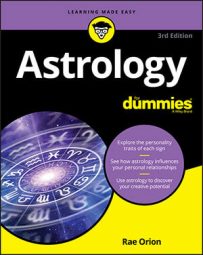- Hemisphere analysis: This one is easy. All you have to do is divide the chart circle in half, once horizontally and once vertically, and count the number of planets on each side.
- Pattern analysis: This method, pioneered by astrologer Marc Edmund Jones in his Guide to Horoscope Interpretation, analyzes the way the planets are strewn around the wheel of the horoscope.
Both methods rely only on patterns, not on signs and planets.
Don't have time to read the entire article? Jump to the quick read summary.
Hemisphere analysis
A quick glance at your horoscope provides an easy entry into interpretation — and all you have to do is count. First locate the horizon line in your chart — the line running from the ascendant to the descendant, as shown. If seven or more planets are above the horizon, you’re an extrovert, who looks to the external world for recognition and endorsement. If most of your planets populate the area below the line, you’re an introvert, who needs privacy, seeks personal fulfillment, and may be uncomfortable in the limelight.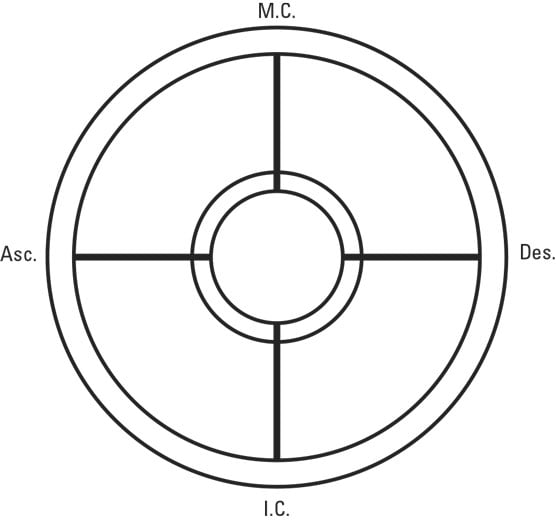 Dividing your chart by the horizon and the meridian
Dividing your chart by the horizon and the meridianNow, divide your chart in half vertically or along the meridian, which runs from your midheaven, or M.C., at the twelve o’clock spot on your chart to your I.C. at the six o’clock spot. That line splits the horoscope into two sectors: the eastern hemisphere on the left and the western hemisphere on the right.
If most of your planets lie on the eastern or left side of the horoscope, you have the enviable ability to make things happen, to pave your own way. You’re highly independent, but you may also be intolerant of people who can’t seem to call the shots the way you can.
If your chart leans to the right, so to speak, with seven or more planets on the western or right side of the circle, you’re more dependent on circumstances than you may appear to be. You need to seize the moment when it arrives, and you may feel that you must bend to the demands of others in order to succeed.
Most of us have planets on both sides of divide, no matter which way you bisect the circle. But there are some people, including the greatest of the great, whose planets occupy only one hemisphere. Serena Williams, the most gifted female athlete on Earth, has all of her planets on the right side of her chart. That doesn’t in any way belittle her accomplishments. It merely suggests that she responds to circumstances and is adaptable. Not so with Beyoncé ― with every one of her planets on the left side of her chart, she is self-reliant and independent, a self-starter with a will of iron.
The ascendant symbolizes your surface personality. The descendant represents your approach to marriage and partnerships. The midheaven — the apex of your chart — describes your ambition and public image. At the bottom of your chart, the imum coeli, or I.C., indicates your attitude toward home and family.
Pattern analysis
In 1941, astrologer Marc Edmund Jones (a Libran) identified seven planetary patterns which, like hemispheric division, operate without regard to specific signs and planets. Ever since then, students of astrology have been exploring the meaning of those patterns. Here they are:- The bundle: If all of your planets are concentrated within four signs or about 120° (a trine), you have a bundle chart, regardless of which signs are involved or where on the wheel that bundle of planets happens to fall. This pattern, shown in the following figure, grants you a clear focus, firm interests, confidence, and personal strength. It also limits you: You’re strong where you’re strong and thoroughly unconscious (or uninterested) where you aren’t. Examples: George W. Bush, Sylvester Stallone, Paul McCartney, and Scarlett Johansson.
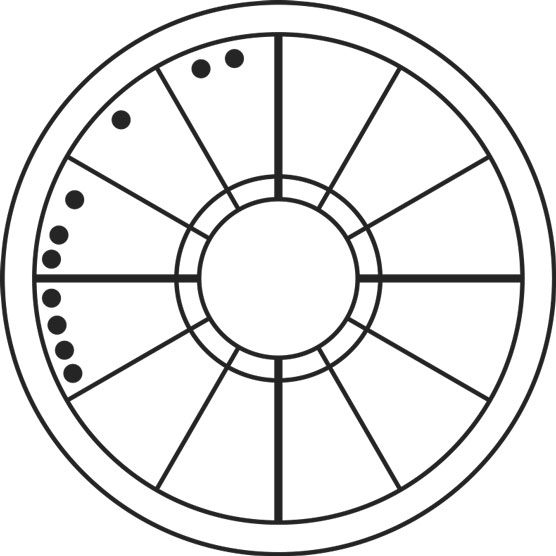 The bundle pattern
The bundle pattern- The bowl: If your planets cover more than 120° but no more than 180° (or half the zodiac), you have a bowl chart, as shown in the following figure. This highly motivating pattern can create a frustrating feeling that something is missing, combined with a determination to fill that void. These people don’t sit around waiting. They’re activists, and they get things done, like it or not. Examples: Abraham Lincoln, Vincent van Gogh, Amelia Earhart, Billie Jean King, Ella Fitzgerald, and Donald J. Trump.
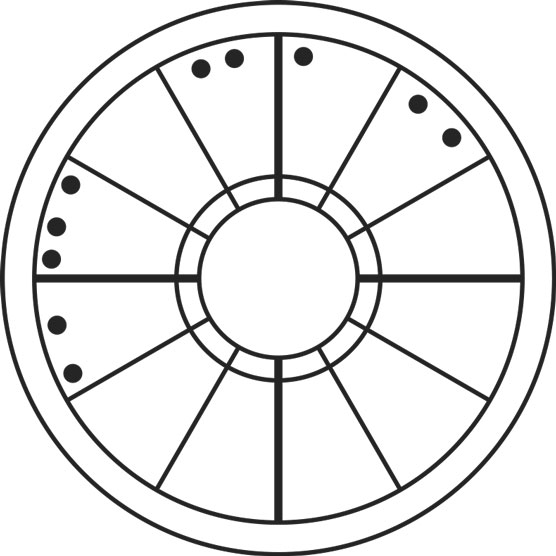 The bowl pattern
The bowl pattern- The bucket: A bucket chart (sometimes called a funnel) is like a bowl except that one planet (or two in close conjunction) is separated from the rest, as in the following figure. That singleton planet, the handle of the bucket, becomes the focus of the chart. Because its needs are always paramount, Marc Edmund Jones compared that lone planet to a toothache. It commands attention — and it hurts. By sign and by house, it acts as a counterweight to the rest of the chart. Four people with bucket charts: Taylor Swift; Harry, Duke of Sussex; Harry’s sister-in-law, Catherine, Duchess of Cambridge; and Alexandria Ocasio-Cortez.
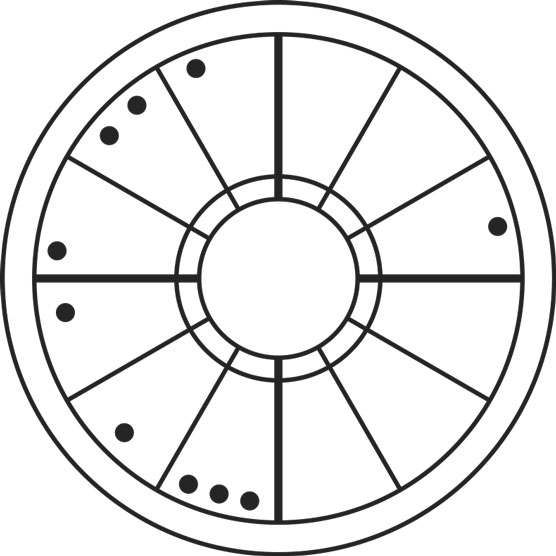 The bucket pattern
The bucket pattern- The locomotive: If the ten planets in your chart line up neatly over two-thirds of the zodiac, as shown in the following figure, you’ve got drive, stamina, and practicality. The two most important planets are the first and the last: the locomotive, which leads the starry parade when the chart is rotated in a clockwise direction, and the caboose, which picks up the rear. Isaac Newton, George Washington, Jennifer Lawrence, and Oprah Winfrey share this pattern.
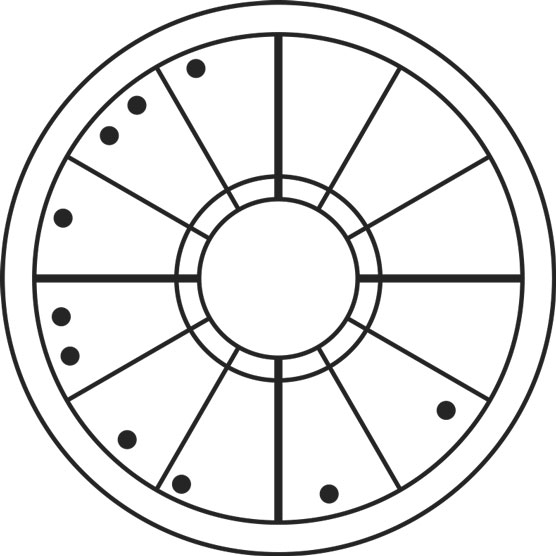 The locomotive pattern
The locomotive pattern- The splash: Just as it sounds, the planets in this relatively rare pattern are sprinkled more or less evenly around the celestial wheel, as in the following figure. With a splash chart, a profusion of experience is yours for the taking. The drawback? Much as you enjoy splashing around in that bright blue pool, your energy can be scattered and diffuse. Examples of the splash at its finest: Isaac Asimov; and the French politician and physician Bernard Kouchner, co-founder of Doctors without Borders.
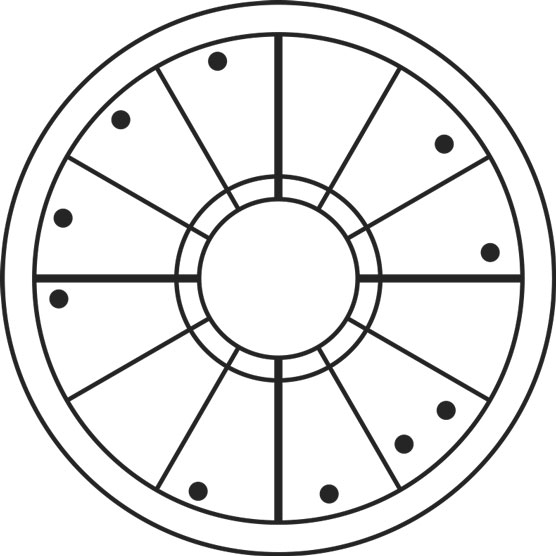 The splash pattern
The splash pattern- The splay: This pattern, shown in the following figure, is similar to the splash except that here, the planets are distributed unevenly over the chart, with as many as three clumps of three or more planets. People with this pattern have a multitude of talents but it takes them a while to find themselves as they ricochet from one activity to another. When at last they settle into something, they are strongly dedicated, refusing to bow to popular opinion or to be pushed. Example: W. B. Yeats.
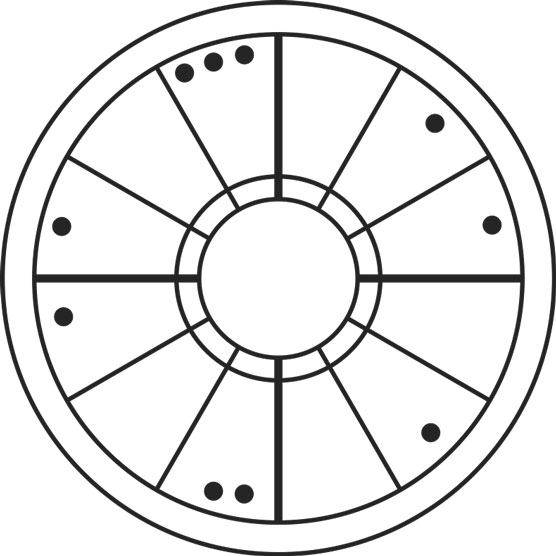 The splay pattern
The splay pattern- The seesaw: If you have two groups of opposing planets separated by a couple of empty houses on each side, as shown in the following figure, you’re always bouncing up and down on the seesaw of circumstance. An excellent mediator, judge, and administrator, you can view things objectively because you’re supremely aware of the two sides of your own nature. But you may feel internally split because you have two sets of needs and talents, and you may find it a challenge to satisfy both. Examples include Whitney Houston, Ted Kennedy, Frank Sinatra, Malcolm Gladwell, Alexander McQueen, and Barack Obama.
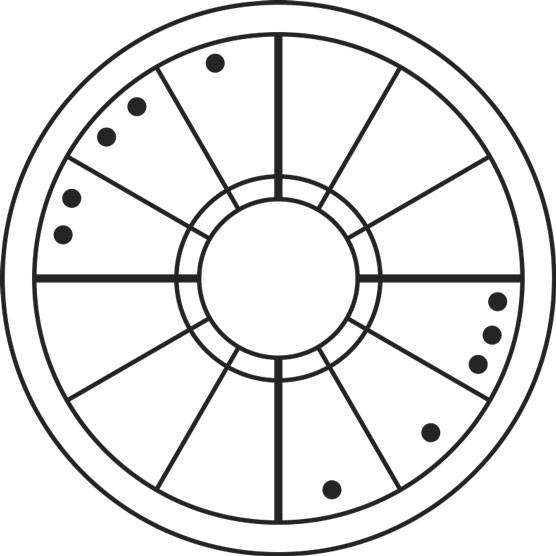 The seesaw pattern
The seesaw patternBe advised: these patterns are valuable aids to interpretation, but sometimes it’s hard to detect any pattern at all. When that happens, forget about finding the perfect label. Don’t think, don’t judge. Just take in the chart as the visual symbol of a soul. Just look.
Consider the signs
After mulling over the patterns of hemispheric division and overall design in your chart, you’re ready to assess your chart according to element and mode. Begin by counting the planets in each element (fire, earth, air, and water) and in each mode (cardinal, fixed, and mutable). The following table shows you which is which. If you know the time of your birth, add your ascendant and midheaven for a total of 12 distinct components. Want to include the effects of Chiron (the comet)? Be my guest. But keep in mind that we’re still learning about it.Elements and modes
| Fire | Earth | Air | Water | |
| Cardinal | Aries | Capricorn | Libra | Cancer |
| Fixed | Leo | Taurus | Aquarius | Scorpio |
| Mutable | Sagittarius | Virgo | Gemini | Pisces |
Most charts are more or less balanced, with two to four planets in each element. If you have five or more planets in signs of one element, the traits associated with that element are emphasized. See the following table for explanations of what such an abundance may mean for you.
Emphasis by element
| With a preponderance of planets in… | You are… |
| Fire signs | Active, spirited, assertive, a natural leader |
| Earth signs | Realistic, sensual, stable, prudent, hard-working, security-minded |
| Air signs | Communicative, intellectual, sociable, fueled by ideas and social interaction |
| Water signs | Sensitive, impassioned, impressionable, compassionate, and insightful |
When classifying the components of a chart, remember that the sun, moon, and ascendant are more influential than other placements and therefore deserve extra weight. Some astrologers even count them twice, just to make sure they get their due.
The modes (or qualities) work the same way as the elements. Most people have an approximate balance. But if you have a pileup of planets in one particular mode, those traits are accentuated. This table tells you more.Emphasis by mode
| With a majority of planets in… | You are… |
| Cardinal signs | Action-oriented, brave, geared up to take the initiative |
| Fixed signs | Unyielding, determined, focused, opposed to change |
| Mutable signs | Versatile, resourceful, open to change |
Missing in action: elements gone AWOL
Elemental voids can affect entire generations. For instance, between 1943 and 1955, Pluto was in Leo, a fire sign, and Neptune was in airy Libra. So, no one born during that those years has a void in either fire or air — which may be why baby boomers, say what you will about them, can’t be faulted for lack of energy (fire) or ideas (air). But among members of that generation, voids in water (emotional awareness) and earth (practicality) are common. Which makes a certain amount of sense.During the 1960s, Neptune was in Scorpio and Pluto was in Virgo, so it was not possible to have a void in water or earth. But a baby born in those years could easily come up short in fire or air — or both, as was the case for Kurt Cobain. He had an astonishing eight planets in water signs plus two voids, one in fire and one in air: an emotional avalanche for anyone.
If you have an elemental void, here’s how it could affect you:
- No fire: It’s hard for you to assert yourself, to maintain a consistent level of enthusiasm, and to mobilize the energy you need.
- No earth: The material side of life eludes and possibly distresses you. Paying the bills on time, keeping track of your keys — these ordinary chores can do you in.
- No air: You react emotionally and personally. It’s hard for you to assess a situation objectively. Dealing with abstractions fills you with apprehension.
- No water: Feelings baffle you. At times you don’t even recognize your own reactions, and you have limited understanding of the emotions of others.
Missing in action: modes in retreat
Missing modes are less common than elemental voids. But they do occur. If you happen to have one, here’s how to interpret it:- No cardinal planets: Taking the initiative isn’t easy for you. When times of change descend upon you, you adjust. But you’d rather stick with the miserable known than risk getting lost in the unknown.
- No fixed planets: You bend with the wind, happily charging off in new directions as the situation calls for it. You might even take pride in your flexibility. The truth is, you lack persistence. That’s your weakness.
- No mutable planets. Bend with the wind? Why would you want to do that? You have the ability to get a new endeavor off the ground and the tenacity to stick with it to the end. But adapting to circumstances? Compromising? Not your high card.
How to find mitigating factors
Here’s the thing: Planets are not the only players. You might have a planetary void in, let’s say, water. But if the ascendant, midheaven, the nodes of the moon, or even Chiron is in a water sign, then that void is not total.House placements can also be a mitigating factor. In the alphabet of astrology, the first house corresponds to Aries, the second house to Taurus, and so on. So, the first house has a hint of fire to it, no matter what sign is on its cusp. The second house has a touch of earth. And so on.
So maybe you have a void in water. But if you have planets in the fourth, eighth, or twelfth house – the houses that correspond to water signs – that alleviates the situation. Those house placements direct your attention in ways that can help balance a slightly out-of-whack chart. This is a subtle influence. But that doesn’t mean it’s not real.
To see this effect in action, take a look at Oprah Winfrey’s chart. She has very little earth in her chart — only Chiron and the north node of the moon. None of her planets inhabit earth signs. But she has three planets in the second house of money and possessions, one in the sixth house of work, and two in the tenth house of career and reputation. So, most of her planets are in the houses associated with earth signs, also known as the houses of substance — which might explain how an idealistic Aquarian got to be one of the richest women in the galaxy.
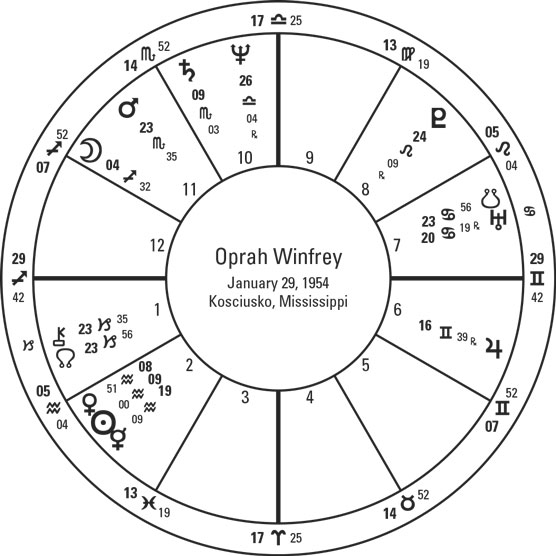 Oprah Winfrey's birth chart
Oprah Winfrey's birth chartHouses and elements
| Houses | Group Name | Characteristics |
| 1, 5, and 9 | Houses of Life (fire houses) | Fiery; vigorous; ready to enjoy life |
| 2, 6, and 10 | Houses of Substance (earth houses) | fond of systems and methods; motivated to seek security and recognition |
| 3, 7, and 11 | Houses of Relationship (air houses) | Communicative; intent on creating fulfilling relationships |
| 4, 8, and 12 | Houses of Emotion (water houses) | Emotional; discerning; interested in delving into family connections, the psyche, and the past |
Houses and qualities
| Houses | Group Name | Characteristics |
| 1, 4, 7, and 10 | Cardinal Houses | Enterprising, active |
| 2, 5, 8, and 11 | Fixed Houses | Stable, unwavering |
| 3, 6, 9, and 12 | Mutable Houses | Thoughtful, adaptable |
Quick Read Summary
Astrology enthusiasts often find valuable insights by examining patterns in astrological birth charts. Two prominent methods for chart analysis are hemisphere analysis and pattern analysis, both of which rely solely on patterns, disregarding specific signs and planets.
Hemisphere analysis
Dividing the birth chart horizontally along the horizon line can reveal personality traits. If most planets are above the horizon, it signifies extroversion, a desire for recognition, and comfort in the external world. Conversely, if planets cluster below the horizon, it indicates introversion, a need for privacy, personal fulfillment, and an aversion to the limelight.
Vertical division along the meridian splits the chart into eastern and western hemispheres. A majority of planets in the eastern hemisphere suggests independence and a self-starter mentality, while a western hemisphere emphasis implies a dependence on circumstances and a willingness to accommodate others' demands.
Pattern Analysis
Pattern analysis identifies seven planetary configurations, irrespective of specific signs and planets:
The bundle: When all planets concentrate within four signs or approximately 120 degrees, it creates a focused, confident, and strong individual. However, it limits versatility.
The bowl: If planets span more than 120 but less than 180 degrees, it leads to highly motivated individuals determined to fill a perceived void. They are proactive and driven.
The bucket: Similar to a bowl, but with one or two planets separated from the rest. This "handle" planet becomes the chart's focal point and commands attention.
The locomotive: When planets align over two-thirds of the zodiac, it indicates drive, stamina, and practicality, with the first and last planets leading the chart.
The splash: Planets are evenly scattered across the chart, offering a wide range of experiences but potentially leading to scattered energy.
The splay: Planets form multiple clumps across the chart, reflecting a diverse range of talents and interests, but it may take time to focus on one.
The seesaw: Two opposing groups of planets separated by empty houses suggest constant balancing of opposing needs and talents.
Consider the Signs
After pattern analysis, examining the distribution of planets among elements (fire, earth, air, water) and modes (cardinal, fixed, mutable) provides further insights. A preponderance of planets in a particular element or mode emphasizes associated traits.
Emphasis by element:
Fire: Active, spirited, assertive, a natural leader.
Earth: Realistic, sensual, stable, prudent, hard-working, security-minded.
Air: Communicative, intellectual, sociable, fueled by ideas and social interaction.
Water: Sensitive, impassioned, impressionable, compassionate, and insightful.
Emphasis by mode:
Cardinal signs: Action-oriented, brave, geared up to take the initiative.
Fixed signs: Unyielding, determined, focused, opposed to change.
Mutable signs: Versatile, resourceful, open to change.
Missing elements or modes in your chart can also offer unique insights into your character and tendencies.
In conclusion, while these techniques provide valuable tools for astrological analysis, remember that individual charts vary, and astrology is a holistic endeavor. Don't rely solely on patterns and elements; consider the unique interplay of signs and planets in your birth chart for a comprehensive understanding of your cosmic blueprint.
Hungry for more? Go back and read the article or check out the book.

